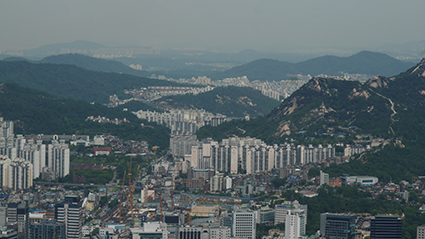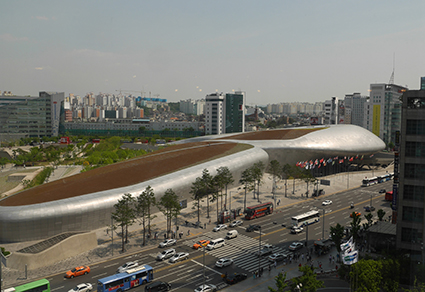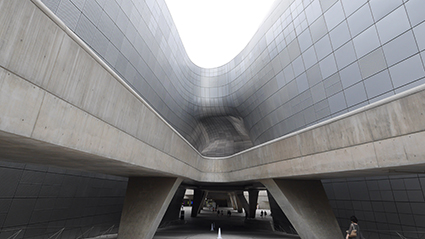 |
Seoul viewed to north from the N-Seoul Tower photo Gail Priest |
Reason for travelling
I headed off to Seoul (as well as Tokyo and Osaka) in search of the future, in particular what the future might sound like. This research feeds into a speculative audio and writing project which I am creating as part of my Australia Council Emerging and Experimental Arts Fellowship.
Lit by neon dreams
I was looking for the future in Seoul because, along with Japan and China, the belated acceptance of Western modernity after an extended period of seclusion has resulted in a slam-down-hard on the fast-forward button in terms of technological progress. Seoul is a super clean, efficient and well-planned city, full of ambitious architectural visions, corporate glamour and an obscene amount of retail activity. Amid this unabashed capitalism, you turn a corner and there’s a mountain outcrop—sheer rock faces and luscious greenery—often hiding an opulent and ancient palace (admittedly reconstructed after the devastations of the Korean war).
By day the streets are curiously calm—I kept wondering where the 10 million people who live in the megacity were hiding. But at night everyone hits the streets which are all neon and video screens (some curved and embedded into buildings Blade Runner-style) and the music is turned up loud—each retail shop blaring its own pop-soundtrack. There’s serious touting (each shop has a shouting MC) and the young primp, pose, promenade and of course purchase. The retail orgy continues underground with kilometres of specialist shops branching out from the subways. These often adjoin subterranean bomb shelters—the not so subtle reminder of underlying tensions in the region.
While the mainstream culture of K-Pop, propped up by government investment, is inescapable and the pressures of fashion and beauty industries are a little overwhelming (plastic surgery is a number one seller), Seoul still has a strong art heart, offering a vast amount of cultural activity. While it’s mainly government and corporate sponsored there’s also a dedicated alternative community that keeps things lively.
 |
Dongdaemun Design Plaza photo Gail Priest |
Seoul’s big art
Guide books divide Seoul up into to seven key areas all accessible by the wonderfully efficient and cheap subway system. To the north is Jongno-gu which includes the gallery clutch of Insadong—an astounding concentration of small commercial spaces—as well as some of the key larger galleries. (Seoul has so many large art institutions with multiple venues that I was often confused as to which government sponsored gallery I was in).
The National Museum of Modern and Contemporary Art (MMCA) has three venues with the Seoul complex only completed in 2013. When I visited it housed a humorously incisive exhibition by Xijing Men, a group whose work critiques the mechanisms behind contemporary constructions of civilised cities (The World of Xijing, until 9 Aug). There was also a major exhibition, Robot Essay, with a not-so-surprising exploration of humanity’s uneasy relationship with robots (until Aug 30). A pleasant surprise was finding the kinetic sculptures of Australian artist Ross Manning included as part of the Interplay exhibition in which artists have been invited to make works “site-specifically” for the underground gallery spaces. The highlight of Interplay is the otherworldly Liminal Air-Descend by Japanese artist Shinji Ohmaki—a fluorescently lit room full of thousands of suspended white strings through which you walk, a little anxiously entangled in its multi-sensory environment (until 23 Aug).
Just around the corner the Art Sonje Centre was hosting a large installation by Mexican artist Abraham Cruzvillegas. For Autodestrucción8: Sinbeyeong, he gathered detritus from an area in Seoul undergoing rapid renovation to create an intricate spiral maze. His placement of disparate objects and materials end-to-end reconfigures the relationships of items in a fascinating way. Reaching the centre you are rewarded with the sight of an otherworldly white axolotl in a terrarium (until 26 July).
Around another corner is the Kumho Museum of Art, one of the many galleries sponsored by major corporations. Until 23 August it’s showing an excellent exhibition, Into Thin Air, offering sound, video and installation work exploring ‘monotone’ as a state. A particularly impressive work by Kim Sangjin deploys hundreds of small speakers, each issuing a single voice in a beautiful chorus. In another room, behind glass and shrouded in real fog, a life-sized, skeletal tree turns slowly in an endless winter, the work of Rhee Kibong. I stumbled upon Kumho, since there was no web information in English. It was one of the most satisfying exhibitions I attended.
 |
Dongdaemun Design Plaza photo Gail Priest |
In the more tourist-drenched area of Iatewon is the luxurious gallery experience that is Leeum, Samsung Museum of Art. Museum 1 houses precious antiquities—porcelain, metalwork and paintings interspersed with a small number of modern minimalist pieces. Museum 2 concentrates on an eclectic collection of contemporary international works by the likes of Rothko, Koons, Judd, Mccarthy, Kiefer and Beuys. And of course, as it seems mandatory these days, there’s an Olafur Eliasson piece which converts a stairway into a sepia Escher etching. Each wing of the gallery has been designed by a different architect—museum 1, Mario Botta, museum 2 Jean Nouvel and the education centre by Rem Koolhaas and the whole complex is guarded by large scale outdoor sculptures by artists such as Louise Bourgeois and Anish Kapoor. (Their website is also excellent, featuring a searchable guide to the collection.) The Samsung Foundation also runs the PLATEAU space in the Jung-gu area. Formerly the Rodin Gallery, its airy atrium holds original bronzes of Rodin’s Gates of Hell and the Burgers of Calais, while the internal gallery spaces feature temporary exhibitions.
Also in Jung-gu is one wing of the Seoul Museum of Art (SeMA) which is responsible for the MediaCity Seoul biennale (last held Nov 2014) with three other venues around the city and including a residency space. Exhibiting an excellent retrospective of the Korean feminist artist Yun Suknam it offered a strong sense of profound and embedded respect for the role of artist as philosopher, critic and visionary within Korean society.
Really, if you blindly stick a pin on a map of Seoul you’re likely to hit a gallery—check the listings guides below for more.
Seoul’s sounds
The inevitable response to the hyperbole of K-Pop, is K-Indie, the ‘underground’ music scene which is now a kind of mainstream in itself. Its home is the Hongdae area (short for Hongik University) in the Mapo-gu district. Full of ‘cool’ young people and heaps of tourists, if you’re looking for live music—rock, reggae, punk, funk, latin—this is the place. (The super-slick gallery Loop Alternative Space is also in the area.) I managed to make contact with a few expatriate Americans who are involved in interesting alternate pop-rock bands—check out Nice Legs and Tierpark if you’re interested.
Looking further underground—for the hard-core experimental—I found a few places, but alas there were no gigs on during my stay. A key space for a kind of non-denominational experimentalism including improv, weird rock, dance and visual art is Expression Gallery Yogiga, run by Hanjoo Lee. For a more concentrated experimental music experience head to dotolim, run by Jin Sangtae. Jin opened his space in 2008 inspired by Ottomo Yoshihide’s GRID605 in Tokyo. The first venue could only fit around 20 people while his current place is just a little bit larger. He runs monthly concerts (up to #74 in the series) featuring local and visiting international artists.
I also managed to chat with other mainstays of the underground noise and electronic scene Hong Chulki and Choi Joonyong who play separately and as the duo Astronoise. Along with Jin Sangtae and a few other key artists, these two have been responsible for most of the experimental sound action in Seoul since the mid-2000s. They run the record label Balloon & Needle and the website is a good resource for what’s going on.
 |
Songdo Future City photo Gail Priest |
Future cities
From an architectural and urban planning perspective, Seoul is racing forward, perhaps not quite at the scale and pace of Dubai and Shanghai, but definitely on its way. One of the newest marvels is the curvaceous “metonymic landscape,” Dongdaemun Design Plaza by architect Zaha Hadid housing galleries, shops and studios. In Seoul’s northwest, near the World Cup Stadium is Digital Media City, a recently constructed precinct designed to attract high-tech companies and home to the Korean Film Archive. It’s an intense collection of steel and glass and shiny public sculptures. At the centre of DMC was to be Seoul Lite Tower, the second tallest building in the world at 640m high, 133 storeys. Construction began in 2009 but was cancelled in 2012 due to budgetary constraints.
Similar overreaching ambition can be seen at Songdo Future City to the south of Seoul near the Incheon Airport. Designed to be an international business hub for North Asia it features multiple housing and business developments on reclaimed land centred on Central Park, a sprawling greenzone and saltwater canal. There are canoes and paddle boats lined up, some deer and even a rabbit island. But currently there’s no one there. One building complex, Tomorrow City, is completely empty and the six-lane motorways are like deserts. It’s weird and wonderfully apocalyptic if you’re into that kind of thing (which I am). Contrast this sparseness with the bustling life of central Seoul’s night markets in Meyondong and Namdaemun and it seems people are still happy to live in a chaotic now, leaving the well-planned future for later.
Thanks to Lauren E Walker, Hong Chulki, Choi Joonyong, Jin Sangtae, Lee Seungjoon and Yoon Jiyoung for taking the time to talk with me.
Gail Priest is a sound artist, writer and curator. Formerly Online Producer and Associate Editor of RealTime, she is currently wandering internal and external worlds in pursuit of the future for her Australia Council for the Arts Emerging and Experimental Arts Fellowship.
Links
Museum of Modern and contemporary Art (MMCA)
http://www.mmca.go.kr/eng/
Art Sonje Centre
http://artsonje.org/main/
Kumho
http://www.kumhomuseum.com/
Leeum Samsung Foundation
http://leeum.samsungfoundation.org
PLATEAU
http://plateau.or.kr/en/html/index.asp
Arko Art Centre
http://www.arkoartcenter.or.kr/
INSA Artspace
http://www.insaartspace.or.kr
Seoul Museum of Art (SeMA)
http://sema.seoul.go.kr/global/main.jsp?sLangCode=02
Expression Gallery Yogiga
http://yogiga.com/wp/?page_id=38
Dotolim
http://www.dotolim.com/
Ballon and Needle
http://www.balloonnneedle.com
Dongdaemun Design Plaza
http://www.ddp.or.kr/MA010001/getInitPage.do
Digital Media City
https://en.wikipedia.org/wiki/Digital_Media_City
Songdo Future City (International Business District)
http://www.songdo.com
Gallery guide sites
Art forum Guide Seoul
http://artforum.com/guide/country=KR&place=Seoul&view=print
Art in Asia
http://www.artinasia.com/gallery.php?catID=6
The Artro
http://eng.theartro.kr/artDirectory/
Art & Seoul
http://artandseoulmag.com
© Gail Priest; for permission to reproduce apply to [email protected]








 back
back